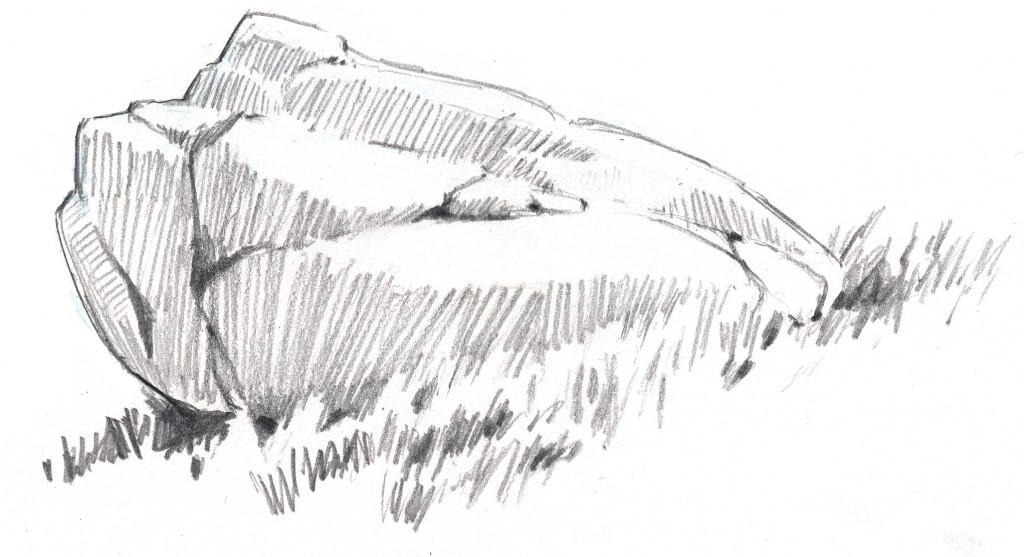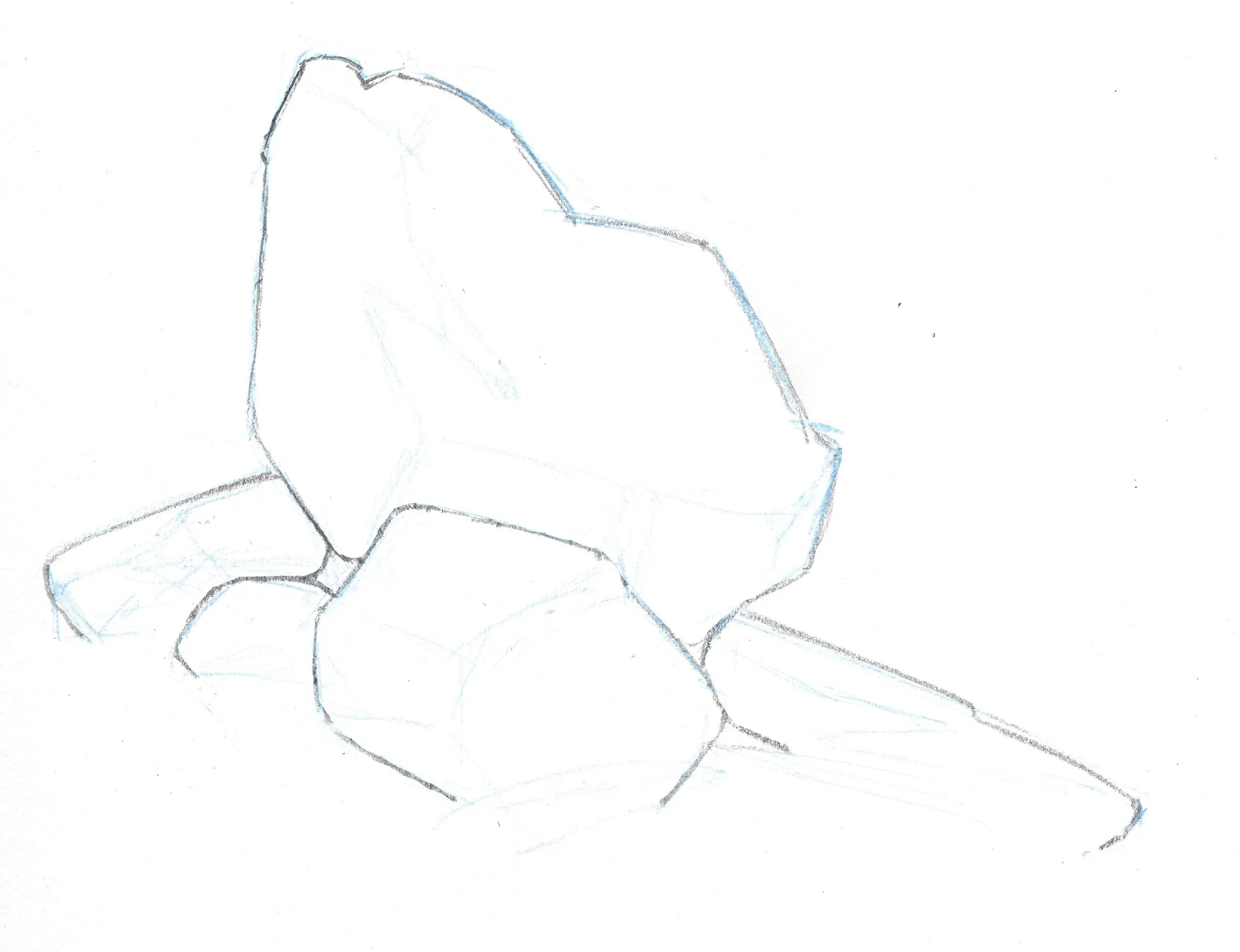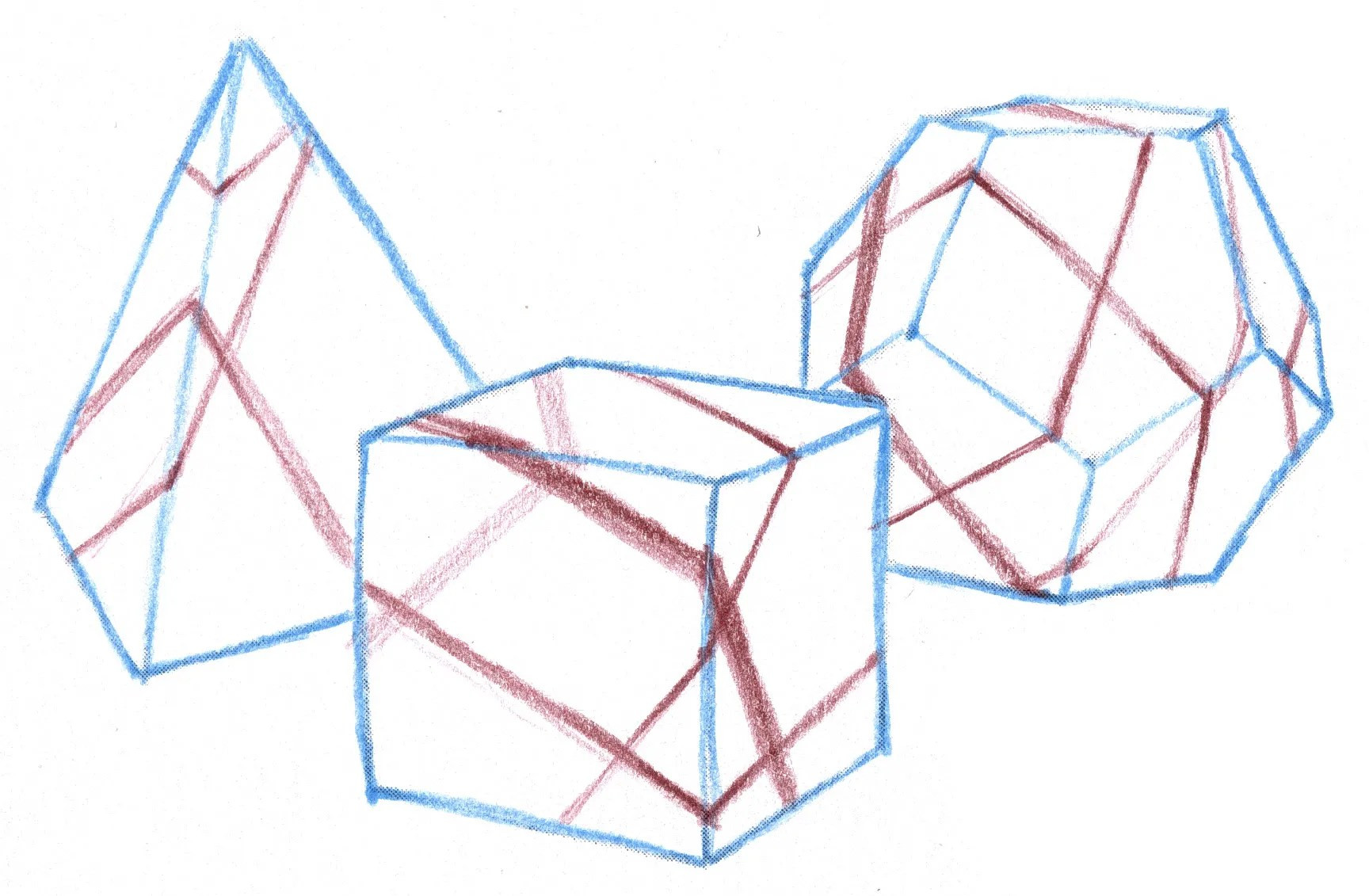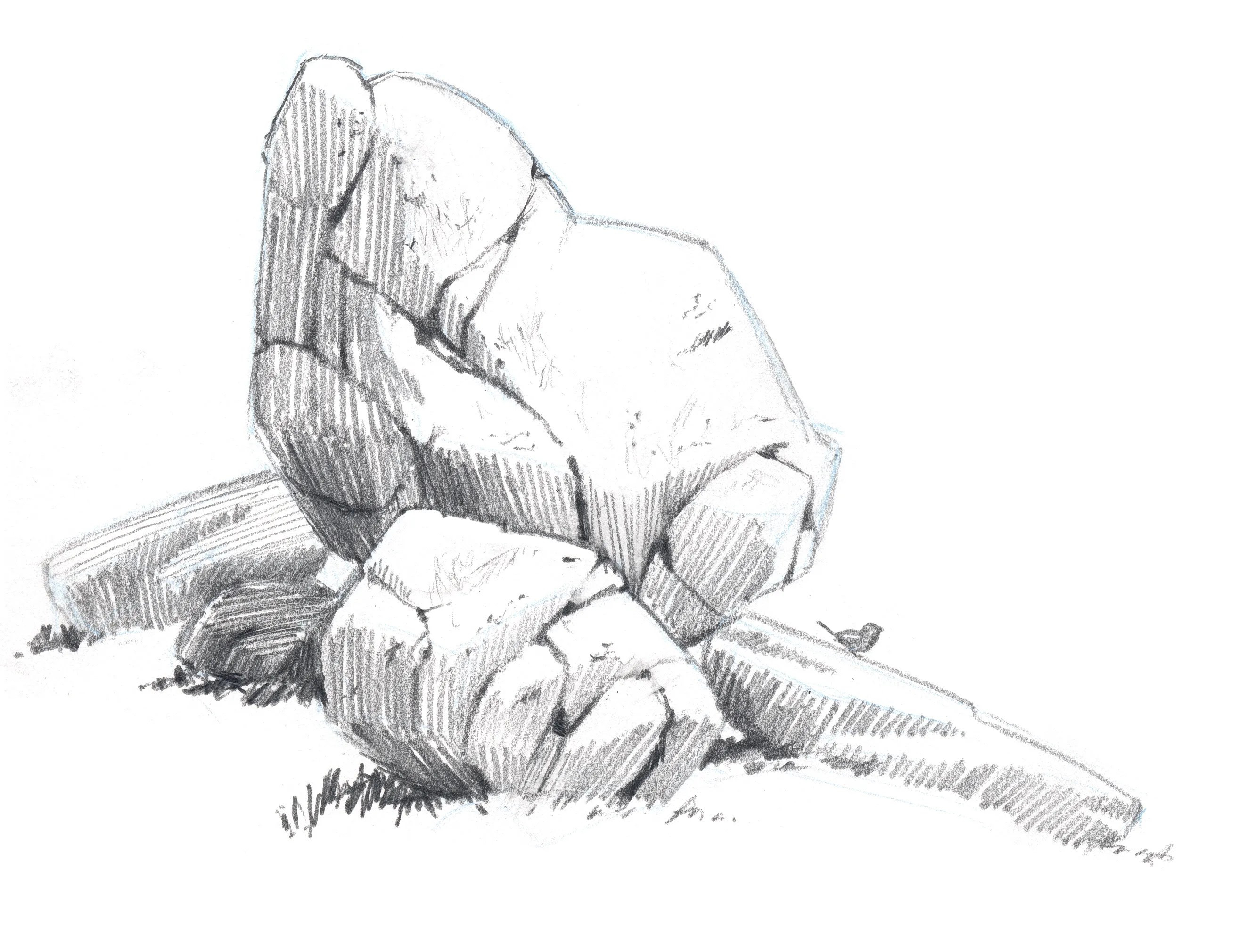Are you fascinated by the beauty of rock formations and want to capture their essence in your drawings? How To Draw A Rock Easy is about understanding their structure, light, and shadow and rockscapes.net provides insights and inspiration to create stunning rock drawings. We will explore techniques to make drawing rocks accessible and enjoyable.
1. Why Learn How To Draw A Rock Easy?
Drawing rocks might seem daunting, but mastering this skill unlocks a world of artistic possibilities.
- Enhance Landscape Drawings: Rocks add depth, texture, and realism to landscape compositions.
- Improve Observational Skills: Drawing rocks requires careful observation of shapes, light, and shadow.
- Boost Confidence: Successfully rendering rocks can build confidence in your overall drawing abilities.
- Creative Expression: Rocks offer endless variations in shape and texture, allowing for unique artistic expression.
- Appreciation for Nature: Learning to draw rocks fosters a deeper appreciation for the natural world.
2. What Basic Materials Do I Need To Draw A Rock Easy?
Before you start, gather the following essential materials to set the stage for your rocky masterpiece.
- Pencils: A range of graphite pencils (HB, 2B, 4B, 6B) for creating various values and textures.
- Eraser: A kneaded eraser for lifting graphite and creating highlights.
- Drawing Paper: Smooth or slightly textured paper that can handle graphite without smudging.
- Sharpener: A sharpener to keep your pencils in optimal drawing condition.
- Reference Images: Photos of rocks or real-life rock formations for inspiration and accuracy.
3. How Can I Simplify Rock Shapes For Easier Drawing?
Simplifying complex rock shapes into basic geometric forms is a crucial first step.
- Identify Basic Shapes: Look for underlying shapes like cubes, spheres, cylinders, or pyramids.
- Break Down Complexity: Divide the rock into smaller, more manageable sections.
- Focus on Volume: Think of the rock as a three-dimensional object, not just a flat outline.
- Use Light and Shadow: Observe how light falls on the rock to define its form and planes.
- Practice Regularly: The more you practice, the easier it will become to simplify complex shapes.
4. What Are The Key Elements Of Rock Structure To Draw A Rock Easy?
Understanding the structure of rocks is essential for creating realistic drawings.
- Planes: Rocks have angled surfaces or planes that define their form.
- Edges: The lines where planes meet, creating sharp or rounded edges.
- Cracks: Fractures or fissures in the rock that add texture and character.
- Layers: Sedimentary rocks often have distinct layers or strata.
- Texture: The surface quality of the rock, which can be rough, smooth, or granular.
5. How Do I Use Light And Shadow To Depict Rock Form Realistically?
Mastering light and shadow is key to creating the illusion of depth and volume in your rock drawings.
- Observe the Light Source: Determine the direction of the light and how it affects the rock.
- Identify Highlight Areas: The areas of the rock that receive the most direct light.
- Create Mid-tones: The areas between the highlights and shadows, providing transition.
- Add Shadows: The areas of the rock that are not directly illuminated, creating depth.
- Use Cast Shadows: The shadows that the rock casts onto the surrounding surface, grounding it in space.
According to research from Arizona State University’s School of Earth and Space Exploration, the interplay of light and shadow is crucial in perceiving the three-dimensional form of geological structures. Understanding how light interacts with different rock surfaces can significantly enhance the realism of your drawings.
6. What Shading Techniques Work Best For Drawing Rocks Easy?
Experiment with different shading techniques to find what works best for you.
- Hatching: Using parallel lines to create value, with closer lines creating darker areas.
- Cross-hatching: Layering hatching lines at different angles to build up value.
- Stippling: Using dots to create value, with more dots creating darker areas.
- Blending: Smudging graphite with a blending stump or tortillon to create smooth transitions.
- Value Scale: Practice creating a value scale to understand the range of tones from light to dark.
7. How Can I Create Realistic Rock Textures When I Draw A Rock Easy?
Adding texture brings your rock drawings to life.
- Observe Real Rocks: Study the textures of different types of rocks, noting their unique characteristics.
- Use a Variety of Strokes: Experiment with different pencil strokes to create various textures.
- Add Cracks and Crevices: Use fine lines and dark accents to depict cracks and crevices.
- Incorporate Small Details: Add small details like pebbles, moss, or lichen to enhance realism.
- Vary Pressure: Vary the pressure on your pencil to create different values and textures.
 Rock Texture
Rock Texture
8. How Do I Draw Different Types Of Rocks Easy?
Each type of rock has unique characteristics that you can capture in your drawings.
- Granite: Characterized by its rough, granular texture and visible crystals.
- Sandstone: Known for its layered appearance and smooth, slightly porous surface.
- Limestone: Often has a pitted or weathered surface and can contain fossils.
- Slate: A metamorphic rock with a smooth, layered structure and a tendency to split into thin sheets.
- Basalt: A dark, volcanic rock with a fine-grained texture and often columnar jointing.
9. What Are Some Common Mistakes To Avoid When Learning How To Draw A Rock Easy?
Be aware of these common pitfalls to improve your rock drawings.
- Ignoring Perspective: Make sure the rock is drawn in perspective, with receding lines converging towards a vanishing point.
- Lack of Contrast: Insufficient contrast between light and shadow can make the rock appear flat.
- Overly Symmetrical Shapes: Rocks are rarely perfectly symmetrical, so avoid drawing them that way.
- Ignoring Texture: Neglecting to add texture can make the rock look artificial.
- Hasty Execution: Take your time and pay attention to detail for a more realistic result.
10. How Can I Practice Drawing Rocks Easy Effectively?
Consistent practice is key to improving your rock drawing skills.
- Draw from Life: Observe and draw real rocks in different lighting conditions.
- Use Reference Photos: Find high-quality reference photos of rocks and try to replicate them.
- Create Studies: Focus on specific aspects of rock drawing, such as texture or shading.
- Experiment with Techniques: Try different drawing techniques to find what works best for you.
- Seek Feedback: Ask for feedback from other artists or instructors to identify areas for improvement.
11. Can You Provide A Step-By-Step Guide On How To Draw A Rock Easy?
Here’s a simplified step-by-step guide to get you started:
- Sketch the Basic Shape: Use a light pencil to sketch the overall shape of the rock.
- Identify Planes: Divide the rock into smaller planes, noting their angles and directions.
- Add Major Shadows: Use a darker pencil to block in the major shadow areas.
- Refine the Shadows: Add mid-tones and refine the shadow shapes for more depth.
- Create Texture: Use a variety of strokes to create the rock’s texture.
- Add Details: Incorporate cracks, crevices, and other details to enhance realism.
- Ground the Rock: Add a cast shadow to ground the rock in its environment.
- Final Touches: Make any final adjustments to values, textures, and details.
 Rock Drawing Steps
Rock Drawing Steps
12. How Does Understanding Geology Help When Drawing Rocks Easy?
A basic understanding of geology can greatly enhance your rock drawings.
- Rock Types: Learn about different types of rocks and their formation processes.
- Geological Structures: Understand how rocks are shaped by geological forces like erosion and weathering.
- Mineral Composition: Knowing the mineral composition of rocks can help you depict their color and texture more accurately.
- Local Geology: Research the local geology of the area you’re drawing to create more authentic rockscapes.
- Inspiration: Geology can provide inspiration for unique and interesting rock formations.
13. What Role Do Cracks Play In Depicting Rock Realism?
Cracks are vital for adding realism and depth.
- Varying Angles: Cracks change angles as they move from one plane to another, enhancing the three-dimensional effect.
- Depth and Dimension: Cracks provide depth and dimension, making the rock look more realistic.
- Shadows and Highlights: Cracks create small shadows and highlights that add texture and visual interest.
- Geological History: Cracks hint at the rock’s geological history, showing how it has been fractured and weathered over time.
- Visual Appeal: Well-placed cracks can dramatically enhance the overall visual appeal of your drawing.
 Rock Cracks
Rock Cracks
14. How Can I Depict The Orientation Of Planes On A Rock Surface?
Showing the orientation of planes is critical for creating a sense of volume.
- Shading Lines: Orient shading lines to follow the contours of the planes, indicating their direction.
- Shadow Placement: The placement of shadows should reflect the orientation of the planes relative to the light source.
- Line Weight: Vary the weight of your lines to emphasize the edges of the planes.
- Visual Aids: Use 3D models or diagrams to visualize how the planes change direction.
- Practice: Practice drawing rocks from different angles to improve your understanding of plane orientation.
15. How Do Light And Dark Wedges Enhance Rock Drawings?
Light and dark wedges are small details that add significant realism.
- Shadow Intrusions: Look for areas where wedges of shadow intrude into the highlight areas.
- Light Creeps: Identify areas where wedges of light creep into the dark areas.
- Shape Interest: These wedges make the shape of the rock much more interesting and dynamic.
- Edge Definition: They help define the edges of shadows, creating a more natural look.
- Subtlety: Add these wedges subtly for the best effect, avoiding overly harsh lines.
16. How Can Texture Be Effectively Added To Rock Drawings Easy?
Texture is essential for conveying the surface quality of rocks.
- Combination of Strokes: Use a combination of scratches and dots to suggest texture.
- Shadow Emphasis: Emphasize texture in areas where shadow transitions to highlight.
- Direct Light Washout: Avoid adding too much texture in areas of direct light, as it tends to wash out details.
- Varying Techniques: Experiment with different texturing techniques to find what works best for different rock types.
- Observation: Closely observe real rocks to understand how light interacts with their textures.
17. What Role Do Shadows At The Base Of Rocks Play?
Shadows at the base of rocks are crucial for grounding them in the scene.
- Weight and Stability: They give the rocks weight and make them appear stable.
- Earth Connection: They connect the rocks to the earth, creating a sense of place.
- Depth Perception: They enhance the perception of depth by creating a clear separation between the rock and the ground.
- Realistic Lighting: They contribute to realistic lighting by showing how light is blocked by the rock.
- Subtle Texture: Add subtle texture within the shadows to suggest grass or other ground cover.
 Rock Base Shadows
Rock Base Shadows
18. How Can I Create A Limited Value Scale For Rock Drawings Easy?
Using a limited value scale can simplify the drawing process.
- Four Values: Aim for about four values: highlight, light mid-tone, dark mid-tone, and shadow.
- Careful Placement: Concentrate on carefully placing these values to carve the shapes of the rock.
- Subtle Shifts: Make subtle value shifts as you move from one plane to another.
- Shape Carving: Focus on carving the shapes made by highlight and shadow.
- Avoid Over-Blending: Avoid over-blending, as it can flatten the values and reduce the sense of depth.
19. What’s The Best Way To Study Real Rocks For Drawing Easy?
Studying real rocks is invaluable for improving your drawings.
- Observe Planes: Learn to see the planes on the rocks, even on rounded boulders.
- Note Shadows and Cracks: Pay attention to how shadows and cracks define the planes.
- Value Scale: Observe the value scale on the rocks, from the brightest highlights to the darkest shadows.
- Light and Dark Wedges: Look for light and dark wedges along the edges of shadows.
- Geological History: Learn about the geology of the rocks to understand their formation and characteristics.
20. How Does Learning Geology Enhance Rock Drawings?
Learning about geology deepens your understanding and appreciation of rocks.
- Rock Formation: Understanding how rocks are formed helps you depict them more accurately.
- Geological Processes: Knowledge of geological processes like erosion and weathering informs your depiction of textures and details.
- Local Context: Learning about the local geology adds authenticity to your drawings.
- Inspiration: Geology provides endless inspiration for unique and interesting rock formations.
- Connection to Nature: It fosters a deeper connection to nature and enhances your artistic expression.
21. What Are Some Advanced Techniques For Drawing Rocks?
For those looking to elevate their rock drawing skills, here are some advanced techniques:
- Complex Textures: Master advanced texturing techniques to capture intricate surface details.
- Atmospheric Perspective: Use atmospheric perspective to create a sense of depth in your rockscapes.
- Color Theory: Incorporate color theory to add realism and visual interest to your drawings.
- Composition: Experiment with different compositions to create dynamic and engaging rockscapes.
- Mixed Media: Explore mixed media techniques to add unique effects and textures to your drawings.
22. How Can I Draw Rocks In Different Weather Conditions?
Weather conditions significantly affect the appearance of rocks.
- Rain: Wet rocks appear darker and more saturated, with enhanced reflections.
- Snow: Snow covers the rocks, softening their edges and creating a blanketed effect.
- Sunlight: Strong sunlight creates high contrast between light and shadow, emphasizing texture.
- Fog: Fog softens the edges of rocks and reduces contrast, creating a hazy atmosphere.
- Overcast: Overcast conditions create soft, diffused light with minimal shadows.
23. How Do I Depict Different Rock Formations Easy?
Different rock formations require different approaches.
- Mountains: Mountains are large-scale formations with complex topography and varied textures.
- Cliffs: Cliffs are steep, vertical formations with sharp edges and dramatic shadows.
- Canyons: Canyons are deep, narrow formations with layered rock walls and winding paths.
- Arches: Arches are natural rock formations with curved openings, often found in desert landscapes.
- Sea Stacks: Sea stacks are isolated rock formations standing in the ocean, often sculpted by waves.
24. How Can I Incorporate Rocks Into Larger Landscape Drawings?
Rocks can be integrated into landscape drawings to add depth and realism.
- Placement: Place rocks strategically to guide the viewer’s eye and create visual interest.
- Scale: Vary the size and scale of the rocks to create a sense of depth and perspective.
- Integration: Integrate the rocks seamlessly into the surrounding landscape by matching their textures and colors.
- Composition: Use rocks to balance the composition and create a harmonious overall image.
- Storytelling: Use rocks to tell a story about the landscape, such as its geological history or the effects of erosion.
25. What Are The Best Resources For Learning More About Rock Drawing?
Numerous resources can help you further develop your rock drawing skills.
- Books: Look for books on drawing rocks, geology, and landscape art.
- Online Courses: Enroll in online courses that focus on rock drawing techniques.
- Workshops: Attend workshops taught by experienced artists and geologists.
- Museums: Visit natural history museums to study rock formations and mineral specimens.
- Field Trips: Take field trips to observe and draw rocks in their natural environment.
26. How To Draw A Rock Easy: Turning Sketches Into Rockscapes?
Expand your rock drawing from single sketches to full rockscapes.
- Consistent Style: Maintaining a consistent drawing style across all elements.
- Harmonious Blending: Blend individual rock drawings together to create a unified landscape.
- Natural Transitions: Ensure natural transitions between different parts of the rockscape.
- Detailed Foregrounds: Adding detailed foreground elements to invite viewers into the scene.
- Use of Light and Shadow: Strategic use of light and shadow to enhance depth and dimension.
27. What Is The Importance Of The Right Tools For Rock Drawing Easy?
Selecting the right tools can significantly impact the quality of your rock drawings.
- Graphite Pencils: Choosing a variety of graphite pencils to achieve different values.
- Kneaded Erasers: Using kneaded erasers to create highlights and correct mistakes.
- Drawing Paper: Selecting paper with the right texture to enhance your drawing style.
- Blending Stumps: Employing blending stumps to create smooth transitions and soft textures.
- Sharpeners: Keeping your pencils sharp to maintain precision in your drawings.
28. How Does Light Intensity Affect Rock Features In Drawings Easy?
Understanding light intensity helps in creating realistic rock drawings.
- High Intensity: High light intensity creates stark contrasts, highlighting textures and details.
- Low Intensity: Low light intensity softens features, creating subtle and diffused effects.
- Shadow Detail: Shadows under high intensity are deeper and more defined.
- Surface Reflection: Surface reflection changes under different light intensities, impacting realism.
- Atmospheric Effects: Atmospheric effects under varying light can alter the perceived depth.
29. What Is The Impact Of Rock Color On Drawings Easy?
Rock color influences the mood and realism of your drawings.
- Color Selection: Choosing colors that accurately represent the rocks in your scene.
- Monochromatic: Using monochromatic schemes to focus on form and texture.
- Complementary Colors: Employing complementary colors to create visual interest.
- Natural Palette: Opting for a natural color palette to enhance realism.
- Color Intensity: Adjusting color intensity to reflect the lighting conditions of the scene.
30. How To Draw A Rock Easy Using Photography?
Photography can greatly aid in drawing realistic rocks.
- Reference: Using photographs as references to capture accurate details.
- Lighting: Studying how light interacts with rock surfaces in different photos.
- Texture: Observing textures and patterns in photographs to enhance realism.
- Composition: Analyzing the composition of photographs to create dynamic drawings.
- Inspiration: Gaining inspiration from professional rock landscape photography.
31. How Can Understanding Weathering Enhance Rock Drawings?
Knowledge of weathering processes improves your rock drawings.
- Erosion: Depicting the effects of erosion through rounded edges and smooth surfaces.
- Chemical Weathering: Showing the results of chemical weathering through pitted textures.
- Biological Weathering: Including the impact of biological weathering with moss and lichen.
- Cracks: Adding cracks and fissures that result from freeze-thaw cycles.
- Surface Detail: Surface details that reflect the specific types of weathering in your environment.
32. How Do You Depict Rock Stratification In Drawings Easy?
Stratification adds depth and realism to sedimentary rock drawings.
- Layered Appearance: Illustrating the layered appearance of sedimentary rocks.
- Color Bands: Including distinct color bands that highlight different strata.
- Uneven Layers: Adding irregularities to the layers to simulate natural formations.
- Fossil Inclusion: Incorporating fossils to enhance realism.
- Detailed Sections: Providing detailed sections to show how layers interact with each other.
33. How To Draw A Rock Easy: Balancing Detail And Simplicity?
Achieving the right balance between detail and simplicity is crucial.
- Selective Detail: Focusing on key details that define the rock’s character.
- Simplified Forms: Simplifying complex areas to maintain clarity.
- Value Range: Using a limited value range to prevent over-complication.
- Strategic Highlights: Strategic highlights to draw the eye.
- Overall Harmony: Ensuring that detail and simplicity work together harmoniously.
34. What Common Mistakes Should Be Avoided When Drawing Easy?
Awareness of common mistakes can greatly improve your drawings.
- Lack of Perspective: Avoiding flat drawings by ensuring proper perspective.
- Ignoring Light: Addressing the light source and its impact on shadows.
- Uniform Texture: Preventing monotonous texture by varying strokes and techniques.
- Oversimplification: Ensuring enough detail to maintain realism.
- Hasty Execution: Taking time to ensure precision and accuracy.
35. How To Draw A Rock Easy: Capturing The Essence?
Focus on capturing the essence of rocks to create impactful drawings.
- Character: Understanding the unique character of each rock.
- Emotion: Infusing emotion and mood into your drawings.
- Connection: Creating a connection between the viewer and the natural world.
- Unique Details: Highlighting unique details that make each rock special.
- Personal Touch: Adding a personal touch that reflects your artistic style.
36. Can You Explain Drawing Rockscapes With Multiple Rocks?
Drawing rockscapes with multiple rocks can create dynamic and engaging compositions.
- Overlapping: Overlapping rocks to create depth and visual interest.
- Size Variation: Varying the sizes of rocks to create perspective.
- Arrangement: Arranging rocks in a natural and balanced manner.
- Shadows: Adding shadows to connect the rocks to the environment.
- Integration: Integrating the rocks seamlessly into the landscape.
37. How To Draw A Rock Easy: Understanding Rock Hardness?
Understanding rock hardness can influence the textures and details you depict.
- Soft Rocks: Depicting softer rocks with smoother textures and rounded edges.
- Hard Rocks: Illustrating harder rocks with sharp edges and rough textures.
- Weathering: Showing how hardness affects the way rocks weather over time.
- Erosion Patterns: Creating erosion patterns that reflect the rock’s hardness.
- Surface Detail: Adding surface details that indicate the rock’s durability.
38. How Do Rock Compositions Interact With Plant Life In Drawings?
The interaction between rocks and plant life can enhance the realism and beauty of your drawings.
- Plant Placement: Strategically placing plants to soften the harshness of rocks.
- Integration: Integrating plants into cracks and crevices to create a natural look.
- Plant Variation: Varying the types of plants to reflect the environment.
- Contrast: Using plants to create contrast in texture and color.
- Harmonious Blend: Ensuring a harmonious blend between the rocks and plants.
Ready to turn your sketches into stunning rockscapes? Visit rockscapes.net for inspiration, detailed guides, and expert tips. Discover the beauty of natural stone and transform your artistic vision into reality. Contact us at 1151 S Forest Ave, Tempe, AZ 85281, United States, or call +1 (480) 965-9011.
FAQ: How To Draw A Rock Easy
- What is the first step in drawing a rock?
Begin by sketching the basic shape of the rock with light pencil strokes. - How do you create depth in a rock drawing?
Use light and shadow to create depth, defining the planes and contours of the rock. - What are some essential tools for rock drawing?
Essential tools include graphite pencils, erasers, drawing paper, and a sharpener. - How do you add texture to a rock drawing?
Add texture by using a combination of strokes, such as hatching, stippling, and blending. - What is the importance of studying real rocks?
Studying real rocks helps you understand their shapes, textures, and how light interacts with their surfaces. - How do you depict cracks and crevices in rocks?
Use fine lines and dark accents to depict cracks and crevices, adding depth and realism. - How do you simplify complex rock shapes?
Break down complex shapes into basic geometric forms, such as cubes, spheres, and cylinders. - What is the role of cast shadows in rock drawings?
Cast shadows help ground the rock in its environment and create a sense of depth. - How does understanding geology enhance rock drawings?
Understanding geology provides insights into rock formation, textures, and characteristics. - How can I improve my rock drawing skills through practice?
Practice regularly by drawing from life, using reference photos, and experimenting with different techniques.